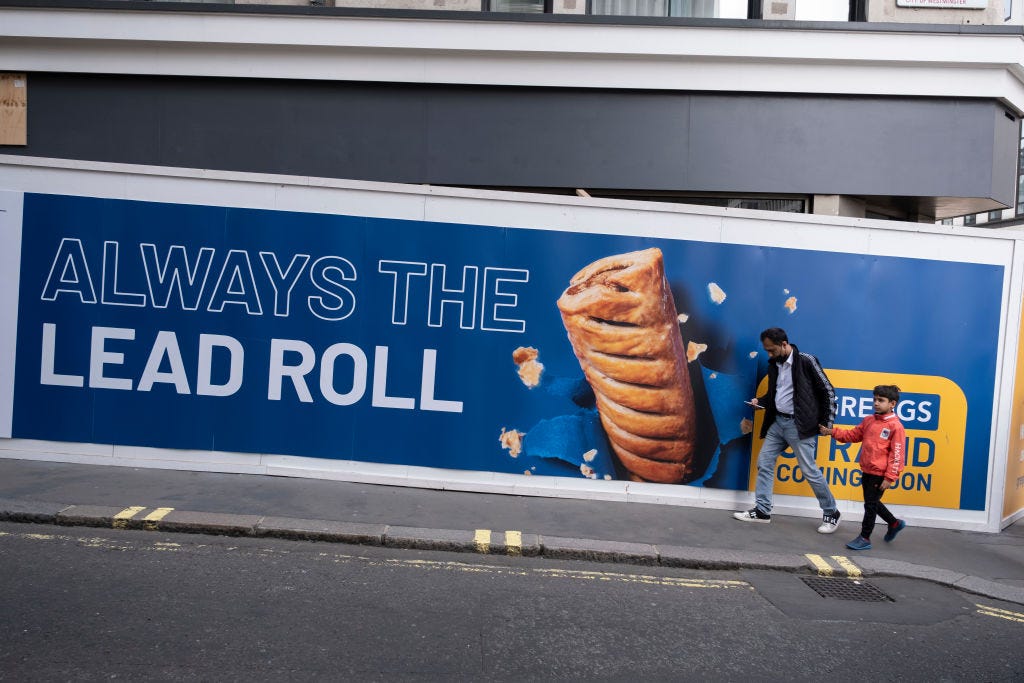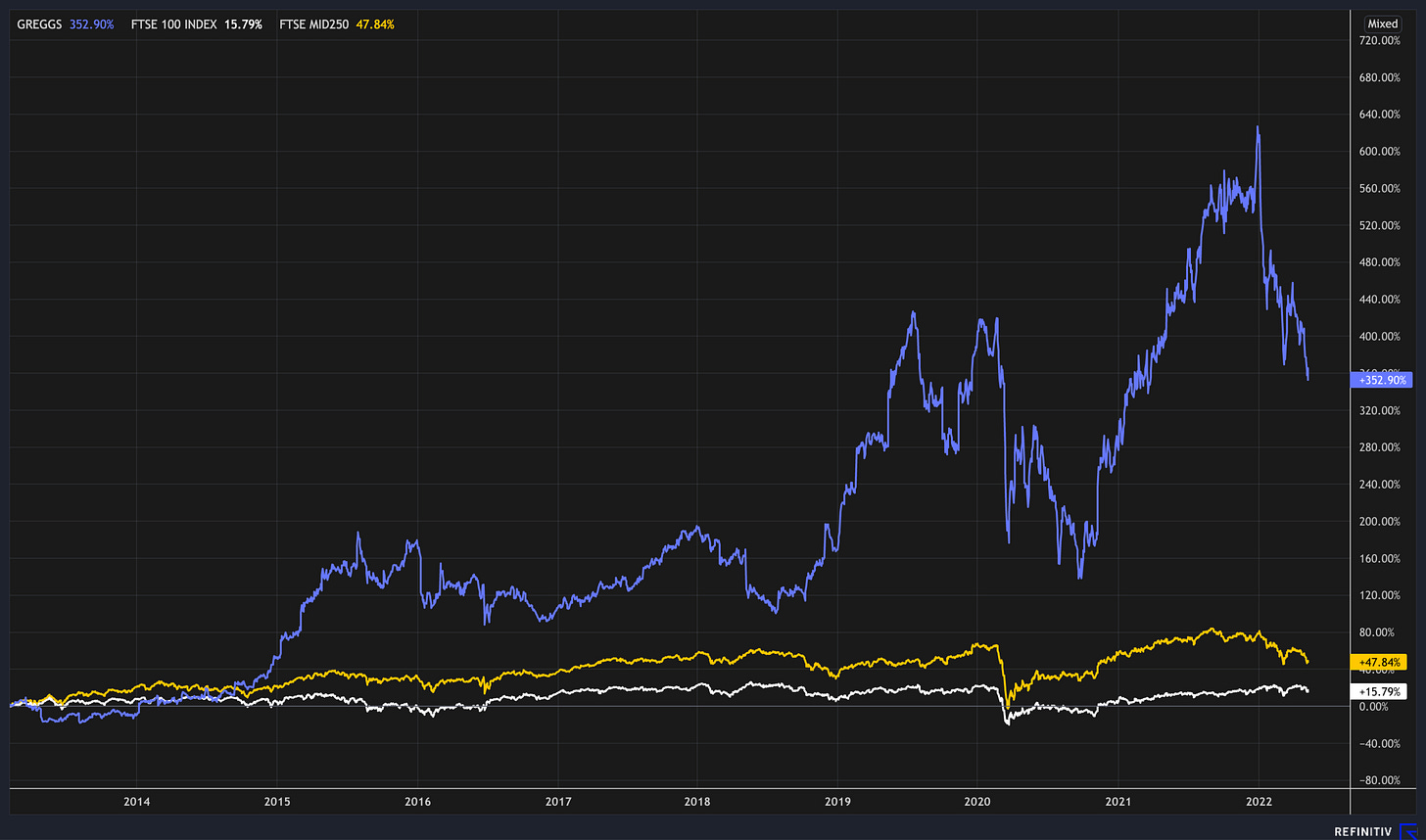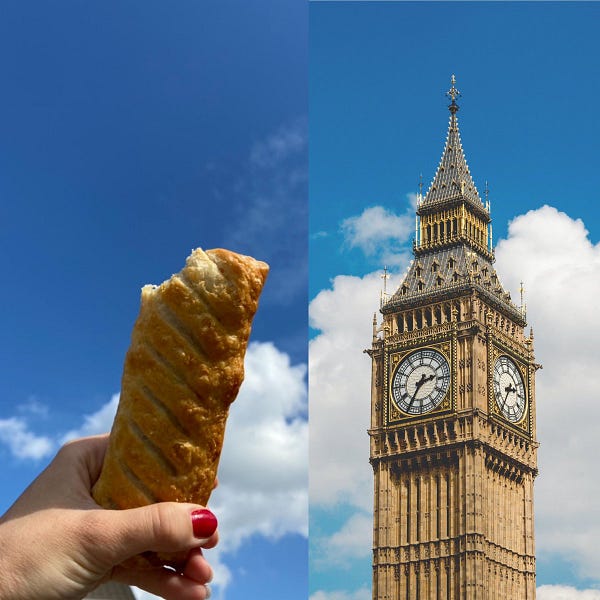Before we look at Greggs, some breaking news from the US, where Elon Musk has tweeted this…


This may be totally unrelated to Musk’s tweet, but before he said this shares in Tesla were down 12 per cent this week, 25 per cent over the last month, and 31 per cent so far in 2022. His Twitter takeover is looking more and more expensive as global markets tumble. However, on the back of this tweet, Tesla shares are up 6 per cent pre-market and Twitter is down 16 per cent. As we have said before, this deal is a long way from being done…
Why Greggs has thrived
Roger Whiteside stands down as chief executive of Greggs on Tuesday after nine years in charge. This remarkable graph shows you how well the bakery chain has done during that time compared to the FTSE 100 and FTSE 250. Greggs is the blue line, the FTSE 100 is white, and the FTSE 250 is yellow…
Despite shares in Greggs falling by just over a third in 2022 amid the wider market turmoil and concerns about Whiteside’s departure (the decline started when Greggs confirmed his exit in January), the bakery chain has still dramatically outperformed the FTSE 100 and FTSE 250 over the last decade. It is the sort of performance you expect from a glitzy tech stock, but this is Greggs, the Newcastle-based high street chain selling sausage rolls, pasties and coffee. The company has grown despite declining footfall on high streets, fierce competition from expanding rivals like Pret A Manager and supermarket convenience stores, and Covid-19 shutting down life across the UK.
Greggs then and now
Greggs has developed a playful image for its brand on social media (see below) and is happy to be seen as a no-nonsense Northern brand. Yet while others in the industry seek publicity for their upmarket, healthy sandwich ranges or coffee subscription services, Greggs is bigger than McDonald’s, Starbucks, Burger King and Pret A Manager. It actually has about 1,800 more units than Pret and, oh, there are fewer calories and less fat in Greggs sausage roll (328 calories, 22g of fat) than many of Pret’s lunch offerings (its posh cheddar and pickle baguette has 651 calories and 28.8g of fat)
So how has Greggs done so well? When Whiteside’s departure was announced, Jonathan Pritchard, a retail analyst at Peel Hunt, said that “few latter-day retail chief executives have had such a marked impact on either a brand or a share price”. Whiteside joined Greggs after 20 years at Marks & Spencer, where he had a stint as head of its food business, as well as running Ocado during its early years (2000 to 2004), off-licence chain Thresher and the pub group Punch Taverns. At Greggs, he oversaw the launch of successful strategic initiatives such as a loyalty card, online delivery through Just Eat, expanded breakfast and evening offerings, and more outlets in petrol stations and service stations through a partnership with the Issa brothers’ EG Group. But Whiteside and Greggs have also just focused on getting the basics right, on being the “customers’ favourite for food-on-the-go”, as the company’s latest annual report says.
Those who work closely with Whiteside have told me he has an incredible attention to detail. He frequently visits Greggs shops and those of his rivals, trying to see what is working and what is not with customers, or why a nearby rival is attracting queues. I interviewed Whiteside in 2013 just after he had taken over. The full interview is on the Telegraph website here. Whiteside was focused on making sure that Greggs was targeting the food-to-go market (ie breakfast or lunch for office workers) rather than selling bread and rolls, which had been the majority of its business in the 1970s but dwindled ever since. He was impressive, speaking with clarity about the strategy and the market (always a strong sign for a chief executive in my view). Greggs was struggling at the time. Despite the brand still being popular (it had just helped to overturn George Osborne’s derided “pasty tax”) its like-for-like sales were falling as it was squeezed by new entrants like Pret and the expansion of Tesco Express, Sainsbury’s Local and M&S Simply Food. “Everyone has a soft spot for them, but they struggle when up against the big boys,” I wrote. This quote from Whiteside still stands out:
“I try not to go to head office, because head office think they know how the business works, but generally don’t. I think I learned more in my first 12 hours in Northumberland Street [in Newcastle] shadowing the manager than I have learned in five years as a non-executive. It’s the detail – everything is always in the detail of execution.”
Getting the basics right included things like cutting 25 per cent of its range of sweet products. “One immediate conclusion I drew was that we have just got way too many products,” he said in the interview.
Without Whiteside, who received an OBE for services to women and equality in 2019, Greggs still has ambitious plans. It wants to double revenues to £2.4 billion by 2026, expand to at least 3,000 shops and widen its evening offering. After Whiteside stands down at Greggs’ annual meeting on Tuesday, he will hand over control to Roisin Currie, the retail and property director, who has been named as the new chief executive.
Crypto chaos
I have spent a lot of time this week speaking to crypto investors and optimists trying to understand their take on the dramatic events of the last few days, with bitcoin, ethereum and other cryptos falling sharply after TerraUSD lost its dollar peg. I would summarise their views like this:
-Yes, what has happened to TerraUSD is not great
-Bitcoin is doing ok to hold where it is for now but could still fall further and there are concerns about the consequences of a margin call at Micro Strategy
-Every nascent technology or market will have volatile ups and downs, look at the dot-com crash in the early 2000s and then the explosion in tech stocks after that
-The vast majority of cryptos that are created will not survive, so there are going to be failures and blow-ups
-Whatever comes out of this downturn will be stronger and it could lead to more regulation of the industry, which would help to endorse cryptos as a valid asset class
For an example of the thinking in the crypto world, check out the latest edition of The Pomp Letter here. For an alternative take, check out this from Nassim Nicholas Taleb. It’s fair to say Taleb is not a fan of bitcoin…


One final point. Whatever your view of cryptos, a lot of people in the UK are staring at heavy losses from their investments this weekend. Last summer the Financial Conduct Authority calculated that 2.3 million adults in the UK held cryptocurrencies, about 4.4 per cent of the population (report here). Different estimates say that proportion has now risen to 6 per cent. In the US it’s 16 per cent according to the New York Times this morning.
You should also read this
Surveillance of staff working in offices has increased dramatically as businesses look to monitor productivity but also protect sensitive information (The Economist, paywall)
It’s the Bank of England’s fault, at least according to some Tory MPs quoted in this FT article. Is this a glimpse of how the Conservative government will try to handle the economic slowdown with voters? This could turn out to be a significant story if so (FT, paywall)
Zara, part of the world’s biggest fashion retailer, Inditex, is to start charging for online returns. Customers in the UK will now have to pay £1.95 to return unwanted items. Given that around a third of online clothing purchases are returned, this is a notable development and part of a growing trend (BBC)
And finally…
It’s almost the weekend, so here’s a bit on a drink to try. I enjoy a decent whisky from time-to-time but until recently that would only be Scottish single malts or occasionally Japanese whiskies that my wife brought from the Japanese Grand Prix. Even then, it had to be something at least 15 years old, with the smoother and cleaner taste that emerges in the older whiskies. However last year I got encouraged to try the new generation of bourbons that are emerging from the US and my preferences have changed (Rowan’s Creek is my favourite). Closer to home, I got a bottle of The One, the blended whisky from the Lakes Distillery, for Christmas. There might be some local Cumbrian bias in this, but it’s delicious. The whisky is a blend of Speyside and Islay whiskies combined with the Lakes single malt. The Lakes Distillery is a success story for Cumbria. My former colleague at The Times, Dominic Walsh, wrote about how it launched a £5 million fundraising earlier this year which valued the business at £57.6 million.
Thanks for reading. Off to Lunch will be back on Monday. If you want to contribute to the work of Off to Lunch, then please sign up for a paid subscription below. Alternatively, please just spread the word!
Graham










